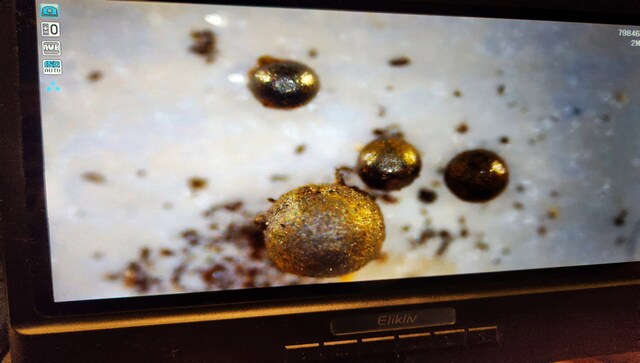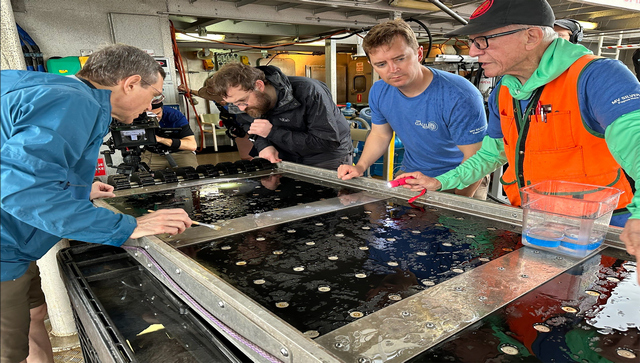A controversial Harvard professor has claimed to have found the first-ever alien objects on Earth. Avi Loeb, a theoretical physicist and professor at Harvard, has claimed to have found particles on the bottom of the Pacific Ocean made of an alloy not seen on Earth. “This is a historic discovery because it represents the first time that humans put their hand on materials from a large object that arrived on Earth from outside the solar system,” Loeb wrote on Tuesday on Medium. “The success of the expedition illustrates the value of taking risks in science despite all odds as an opportunity for discovering new knowledge.” But has Loeb, who was the longest-serving chair of astronomy at Harvard University, actually found discovered objects? Let’s take a closer look: What happened? As per USA Today, a meteor burned up the Earth’s atmosphere in January 2014. The meteor, which exploded into fragments, went down around 100 kilometers off the coast of Manus Island in Papua New Guinea.
US government sensors captured information from the object later designated IM1.
But no one took note of it for the next few years – until Loeb and an undergraduate at Harvard drew attention to it in 2019 and published research on it. Then, in 2022, US Space Command dropped a bombshell in a letter to NASA – the meteor was likely from another solar system. As per Moneycontrol, Loeb and his team then determined that IM1 was tougher than all the meteors in NASA’s Center for Near Earth Object Studies (CNEOS) catalogue. Loeb then declared that he would attempt to retrieve the fragments of the meteor from the ocean floor. “Intrigued by this conclusion, I established a team that designed a two-week expedition to search for the meteor fragments at a depth of 1.7 kilometers on the ocean floor,” Loeb said. Loeb and his team secured $1.5 million of funds for the expedition from entrepreneur Charles Hoskinson. Loeb and his team in June employed EYOS Expeditions and set off in a boat named the Silver Star bound for Papa New Guinea. [caption id=“attachment_13059092” align=“alignnone” width=“640”] The expedition team on the deck of the Silver Star in June. Image courtesy: Avi Loeb/ Medium[/caption] As per BBC, Loeb used a device he claimed to have invented called the “interstellar hook” to collect potential samples off the ocean floor. As per The New York Times, the team dragged this ‘interstellar hook’ across the seafloor for weeks. They found glimmering beads which were under a millimetre in diameter. Loeb and his team claimed to have found 700 spherules at the bottom of the Pacific Ocean, as per Jerusalem Post. Thus far, 57 of them have been analysed. What is Loeb claiming? Loeb is claiming that early examination shows that some of the spherules have “extremely high abundances” of a composition of heavy elements never been seen before, as per USA Today. Researchers claim that the composition of Beryllium, Lanthanum and Uranium – which they have named “BeLaU” – does not match either terrestrial alloys found on the Earth or fallout from nuclear explosions.
The expedition team on the deck of the Silver Star in June. Image courtesy: Avi Loeb/ Medium[/caption] As per BBC, Loeb used a device he claimed to have invented called the “interstellar hook” to collect potential samples off the ocean floor. As per The New York Times, the team dragged this ‘interstellar hook’ across the seafloor for weeks. They found glimmering beads which were under a millimetre in diameter. Loeb and his team claimed to have found 700 spherules at the bottom of the Pacific Ocean, as per Jerusalem Post. Thus far, 57 of them have been analysed. What is Loeb claiming? Loeb is claiming that early examination shows that some of the spherules have “extremely high abundances” of a composition of heavy elements never been seen before, as per USA Today. Researchers claim that the composition of Beryllium, Lanthanum and Uranium – which they have named “BeLaU” – does not match either terrestrial alloys found on the Earth or fallout from nuclear explosions.
The composition has not been discovered in the magma oceans of Earth, on the Moon, on Mars or any other natural meteorites in this solar system.
Researchers say four laboratories – Harvard University, University of California, Berkeley, the Bruker Corporation, and the University of Technology in Papua New Guinea – continue to study the objects and their origins. Hoskinson, meanwhile, also touted the findings. “This is a historic discovery, marking the first time that humans hold materials from a large interstellar object," Hoskinson said in a statement as per USA Today. “I am extremely pleased with these results from this rigorous scientific analysis.” According to The Independent, Loeb has argued that IM1 isn’t one of a kind. There could be “a few million such objects reside within the orbit of the Earth around the Sun at any given time” and that “some of them may represent technological space trash from other civilizations,” Loeb has claimed. [caption id=“attachment_12920582” align=“alignnone” width=“640”] A photo provided by Dr Avi Loeb shows a screen displaying spherules in the microscope image of magnetic particles from a session of dredging the ocean floor. The New York Times[/caption] This isn’t the first time Loeb has made such big claims. Loeb in 2018 claimed the comet “Oumuamua" – the first interstellar immigrant found in our solar system – may have been an alien probe sent to investigate Earth. Loeb said that the elongated dark-red object, which is 10 times as long as it is wide and travelling at speeds of 315,364 km per hour (kmh), might have an “artificial origin”.
A photo provided by Dr Avi Loeb shows a screen displaying spherules in the microscope image of magnetic particles from a session of dredging the ocean floor. The New York Times[/caption] This isn’t the first time Loeb has made such big claims. Loeb in 2018 claimed the comet “Oumuamua" – the first interstellar immigrant found in our solar system – may have been an alien probe sent to investigate Earth. Loeb said that the elongated dark-red object, which is 10 times as long as it is wide and travelling at speeds of 315,364 km per hour (kmh), might have an “artificial origin”.
“‘Oumuamua may be a fully operational probe sent intentionally to Earth vicinity by an alien civilization,” Loeb wrote.
“‘Oumuamua showed unusual features since its discovery. These features make ‘Oumuamua weird, belonging to a class of objects that we had never seen before. ““Oumuamua” deviates from a trajectory that is solely dictated by the Sun’s gravity. This could have been the result of cometary outgassing, but there is no evidence for a cometary tail around it.” Loeb’s claims were rejecting by many scientists. Which is perhaps why some within the scientific community remain sceptical about Loeb’s recent proclamations. Scepticism abounds Karl Gebhardt, one of the astrophysicists who discovered the M-sigma relation, told The New York Times he wanted the media to ‘stop indulging Loeb’s over-the-top ideas. “People are sick of hearing about Avi Loeb’s wild claims,” Steve Desch, an astrophysicist at Arizona State University, told the newspaper in July_._ “It’s polluting good science — conflating the good science we do with this ridiculous sensationalism and sucking all the oxygen out of the room.” Desch told the newspaper many of his colleagues were now refusing to peer-review Loeb’s work – the gold standard for researchers.
“It’s a real breakdown of the peer review process and the scientific method,” Desch added. “And it’s so demoralizing and tiring.”
But regardless of what the critics say, Loeb remains defiant. “It’s not a matter of science fiction,” Loeb told CNN. “It’s not a matter of people talking about it in talk shows or politicians discussing it in the Congress. It’s something that scientists can get to the bottom of.” As per The Independent, Loeb has also slammed his peers, saying that he is “running away from colleagues who have strong opinions without seeking evidence, and I am running towards a higher intelligence in interstellar space.” Loeb says he wishes “happiness and prosperity” for his critics. With inputs from agencies
)